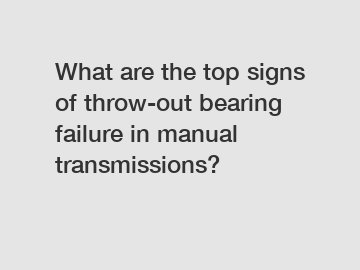What are the top signs of throw-out bearing failure in manual transmissions?
What are the top signs of throw-out bearing failure in manual transmissions?
The throw-out bearing, also known as the clutch release bearing, is an essential component in a manual transmission system. It is responsible for disengaging and engaging the clutch by pressing against the clutch pressure plate. Like any other mechanical part, the throw-out bearing can wear out over time, leading to potential failure. Recognizing the signs of throw-out bearing failure can help prevent further damage to the transmission and ensure a safer driving experience.
Unusual Noise.

One of the most common signs of throw-out bearing failure is the presence of unusual noise. You may notice a grinding or growling sound when applying pressure on the clutch pedal or when the transmission is in neutral. This noise can also intensify as you press the clutch pedal further. These sounds occur due to excessive wear or damage to the throw-out bearing, resulting in metal-on-metal contact.
Difficulty Shifting Gears.
Another telltale sign of throw-out bearing failure is difficulty in shifting gears. You may experience resistance or a grinding sensation when trying to shift gears, especially when moving to lower gears. This is a result of the throw-out bearing not fully disengaging the clutch, causing improper synchronization between the gears. If left unaddressed, this can lead to further transmission issues and potential gear damage.
Vibrations and Feedback.
A failing throw-out bearing can also cause noticeable vibrations and feedback in the clutch pedal. You might feel a pulsating sensation or vibrations in the pedal when engaging or disengaging the clutch. These vibrations occur due to the wear or misalignment of the throw-out bearing, causing irregular pressure distribution throughout the clutch system. Ignoring these vibrations can lead to premature wear on other clutch components.
Clutch Slippage.
Clutch slippage is another indicator of throw-out bearing failure. If you notice that the clutch does not engage fully or that the engine revs increase without a corresponding increase in vehicle speed, it indicates that the clutch is not properly disengaging. This is often caused by a worn-out throw-out bearing that is not providing enough pressure on the clutch pressure plate, leading to incomplete engagement.
Bearing Noise When Clutch Pedal Is Fully Disengaged.
When the throw-out bearing is severely worn or damaged, you may hear a constant noise even when the clutch pedal is fully disengaged. This noise typically sounds like a high-pitched whirring or squealing when the transmission is in neutral. Over time, this noise may become more prominent and worsen as the throw-out bearing continues to deteriorate.
Closing Paragraph:
If you suspect or experience any of the signs mentioned above, it is crucial to have your throw-out bearing inspected and replaced if necessary. Ignoring throw-out bearing issues can lead to more severe transmission problems and potentially leave you stranded on the road. At our service center, our skilled technicians can diagnose and address throw-out bearing and transmission issues promptly. Contact us today to schedule an appointment and ensure a safer and smoother driving experience.
If you are looking for more details, kindly visit cross and roller universal joint, 62tb0629b29, clutch release bearing function.


